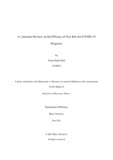A literature review on the efficacy of test kits for COVID-19

View/Open
Date
2021-07Publisher
Brac UniversityAuthor
Sajid, Saiara SajitaMetadata
Show full item recordAbstract
SARS-CoV-2, a beta coronavirus of the coronaviridae family, is responsible for the ongoing pandemic which has resulted in almost 194 million cases with more than 4 million deaths. The common manifestation of this disease involves fever, coughing, sneezing, etc., which are quite similar as common coronavirus infections. The prognosis of the disease ranges from mild and moderate to severe and ultimately death. Being an RNA virus, extensive mutations result in manifestations of a variety of symptoms which include diarrhea or blood clotting or affecting the central nervous system.
However, early diagnosis can be utilized as a powerful weapon against fighting with this virus, and thus cautious observation of the symptoms and undergoing adequate diagnosis is greatly essential. In this review article, the reliability of the two most commonly used diagnosis methods (Molecular Testing and Serological Testing) for detecting the covid-19 virus are discussed by comparing their diagnostic accuracy, patient compliance, and feasibility. In the case of comparing their diagnostic accuracy, several parameters such as sensitivity, specificity, PPV (Positive Predictive Value), NPV (Negative Predictive Value), and LOD (Limit of Detection) are taken into consideration. According to these parameters, a brief comparison of the test kits' company claim with the authorized governmental laboratory evaluation of different countries (such as the USA, UK, France, Saudi Arabia, Malaysia, etc.) is illustrated. Additionally, a brief idea of the basic mode of action of those test kits and background information about the disease itself is also provided.
